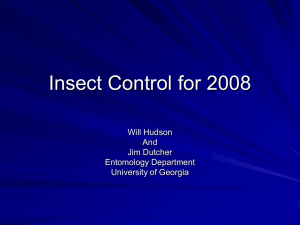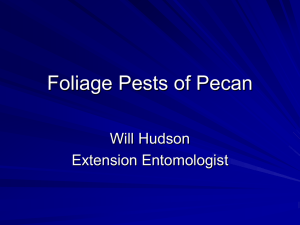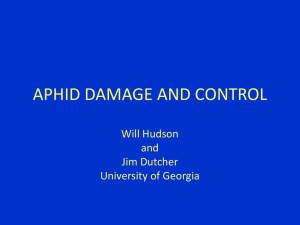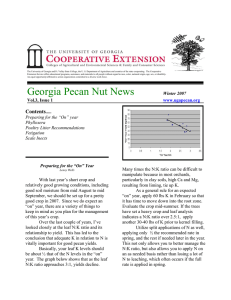2010 GPGA Meeting Dutcher
advertisement
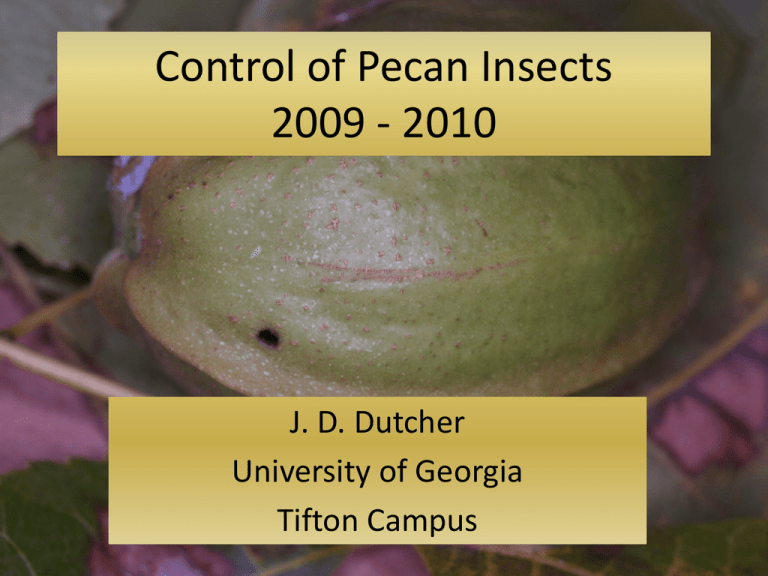
Control of Pecan Insects 2009 - 2010 J. D. Dutcher University of Georgia Tifton Campus Objectives • Determine the efficacies of a new chemical control of pecan aphids. • Screen pecan cultivars for low aphid population development. • Measure the efficacies of multicolored Asian ladybeetle for biological control of pecan aphids. • Find an effective Prionus root borer attractant. Acknowledgement • Thanks to: – Georgia Agricultural Commodity Commission for Pecans for research support funds. – Drs. Haider Karar and Ghulam Abbas for research on aphid population dynamics on different cultivars and MALB efficacy. – Liz Wiggins for research work on convergent lady beetle efficacy. – Mary Jo Townsend and Eric Goodwin for work on the efficacy of pesticides. Aphid Biology Yellow pecan aphid adult and nymph Black pecan aphid adult and nymph 3 species inhabit the foliage Yellow pecan aphid, Monelliopsis pecanis Bissell Black pecan aphid, Melanocallis caryaefoliae (Davis) Blackmargined aphid, Monellia caryella (Fitch) Blackmargined aphid adult During the presentation we’ll use the term “yellow aphids”. Blackmargined aphid and yellow pecan aphid nymphs are difficult to distinguish in the field while counting. The counts for these two aphids are lumped together and labeled as “yellow aphids”. Seasonal Occurrence of Pecan Aphids All three species have similar biology Eggs (overwintering stage) >>>>>> Asexual generations >> >>>>>>> >>>>Unknown>>>>>>> >>>>Asexual generations >Sexual Forms (High T, Leaf Condition, Alt. Host) All three species hatch out in Spring Blackmargined aphids are most abundant in spring and the again in the Fall Black pecan and yellow aphids and pecan leaf scorch mites in mixed culture in the Fall Eventually, one species will become the predominant species Effective Aphid Control Methods • • • • • • Systemic insecticides Reduced N fertilizer rates Tolerant pecan cultivars Foliar insecticidal sprays Importation of natural enemies Conservation biological control – – – – Supplying alternate prey with intercrops Food sprays to attract predators to the foliage Ant control Use safer insecticides for aphid predators against nut pests Efficacy of New Material Yellow Aphids/leaf Sprays applied on July 20, 2009 Black Pecan Aphids/leaf Aphid Abundance In Pecan Weevil Control Treatments Yellow aphids/shoot 5-Sep 12-Sep Black pecan aphids/shoot 19-Sep 5-Sep Baythroid 20W 1.0lbs Baythroid 20W 1.0lbs Baythroid 20W 0.5 lbs Baythroid 20W 0.5 lbs Baythroid 2E 13.7 oz Baythroid 2E 13.7 oz Baythroid 2E 6.6 oz Baythroid 2E 6.6 oz 19-Sep Provado 3.5 oz+Lorsban… Provado 3.5 oz+Lorsban… Provado 7 oz Provado 7 oz Sevin 80S 3 lbs Sevin 80S 3 lbs Control Control 0 12-Sep 50 100 150 200 250 300 Yellow aphids per shoot 0 20 40 60 80 100 120 Black Pecan aphids per shoot 2009 Visiting Scholars Research on HPR and Biocontrol Methods and Materials Objective 2: Cultivar Differences Aphid abundance varied between 23 different pecan cultivars in a provenance collection in Tift Co., Ga. Cultivars were ranked by the number of aphids per week over a 14 week period and then each of the cultivars was qualitatively evaluated based on the seasonal occurrence of the three aphid species. Trees were bearing fruit and at 12 – 80 years old. The orchard was treated with routine fungicide sprays, no insecticide sprays and standard mowed sod with herbicided tree rows for weed control. Fertilizer was applied 2 times at 100 lbs actual N as 10-10-10 in the early and late spring. Data were analyzed with GLM Procedure (SAS) to determine if cultivar and tree age were significant sources of variation in the data. Black Pecan Aphid Means below the same tan bar are not significantly different P<0.01, Proc GLM, DMRT Blackmargined Aphid Means below the same tan bar are not significantly different P<0.01, PROC GLM, DMRT Yellow Pecan Aphid Means below the same tan bar are not significantly different P<0.01, PROC GLM, DMRT Pecan Cultivar - Alley Pecan Cultivar – Schley Pecan Cultivar - Kiowa Pecan Cultivar – Melrose Pecan Cultivar – Moneymaker Pecan Cultivar - Elliot Pecan Cultivar - Curtis Pecan Cultivar – Van Deman Pecan Cultivar – Zinner Pecan Cultivar – Sioux Pecan Cultivar – Merrimac Pecan Cultivar - Barton Pecan Cultivar – Register Pecan Cultivar - Candy Pecan Cultivar – Lineberger Pecan Cultivar – Moreland Pecan Cultivar - Jackson Pecan Cultivar – Stuart Pecan Cultivar - Amling Pecan Cultivar - Faircloth Pecan Cultivar – McMillan Pecan Cultivar - Gafford Pecan Cultivar – Lager 1 Reproductive rate of 3 aphid species on selected pecan cultivars over 3 days a b b ab bc ab bc ab c a ab a b ab ab Reproductive rate of 3 aphid species on selected pecan cultivars over 6 days abc a a a ab a c a bc a a a a a a Multicolored Asian Ladybeetle Research for 2009 • The interactions between Multicolored Asian ladybeetles and aphids were observed in sleeve cages on large Kiowa and Moreland pecan trees in Tift Co. Aphid colonies were started as single species populations and as mixed populations of three species and beetles were introduced after 12-18 days of population growth. Cages were monitored every 3-5 days for aphid abundance in cages with beetles and cages without beetles Sleeve Cages Blackmargined Aphid Yellow Pecan Aphid Date of release of H. axyridis adult in the cages was 4-Aug Black Pecan Aphid Date of release of H. axyridis adult in the cages was 4-Aug Mixed Aphid Populations with and without Harmonia axyridis in cage - Kiowa No Beetles 3 Beetles Treatment – No Beetle Treatment – 1 Beetle/cage Ladybeetles on Tuliptree Ladybeetles on Birch Ladybeetles on Muscadine Grape Ladybeetles on Crape Myrtle Ladybeetle on “Desirable” Pecan Multicolored Asian Ladybeetle Adult convergent ladybeetles on annual plants Sesbania Buckwheat Interaction with Ants Sesbania Ladybeetle eggs undisturbed by ants Convergent ladybeetle on buckwheat Ants interfere with ladybeetles on buckwheat Bringing in Convergent Ladybeetles Mass release of Convergent Ladybeetles Labeling Release Peak blackmargined aphid abundance on pecan leaves in 100 tree orchard blocks with and without ladybeetles 6 weeks after release on May 17 Summary and Conclusions • Obj. 1: The new insecticides controlled yellow aphids and suppressed the black pecan aphid populations. The standard Movento spray treatment was the best control. • Obj. 2: Lager-1, Amling and Gafford and Curtis had very low aphid populations during the entire season whereas, Alley, Stuart and Schley at the same site high significantly higher populations. • Obj. 3: - Harmonia axyridis directly reduces yellow pecan aphid populations and latently reduces blackmargined and black pecan aphid populations in single species cultures. In mixed cultures all three aphid species are eventually are controlled by the beetles but at different rates. Convergent ladybeetle looked great in the cages and mediocre in the field. 2009 Root Borer Research - Prionus root borer pheromone discovered at UC-Davis and field trials at UGA, UA, UI, NMSU, USU and UEA Prionus catch at Tifton and Cordele No. captured in Location in North America or Europe Prionus spp. pheromone/ control traps North America Arizona linsleyi 1/0 California californicus 128/0 lecontei 12/0 imbricornis 140/0 laticollis 115/0 californicus 803/6- integer 2/0 californicus 236/26 nov. sp. 3/0 N. Mexico aztecus 26/3 East Anglia coriarius 11/0 Georgia Idaho Utah United Kingdom 2010 Trials with pheromones plus attractants in above ground traps Black Pecan Aphids per leaf in Admire Pro treated and nontreated pecan trees - 2009 Yellow Aphids per leaf in Admire Pro treated and nontreated pecan trees - 2009 Admire Trial 2009 The test is a Enzyme-Linked ImmunoSorbent Assay where: • Pesticide residue in the leaf is extracted with methanol • The actual pesticide molecules compete with enzyme labeled pesticide molecules for a limited number of antibody binding sites on the inside surface of the test wells. • The reaction is stopped after one hours and the outcome of the competition is visualized with a color development reaction. – Darker Color = Lower Concentration – Lighter Color = Higher Concentration Concentration of Imidacloprid (ppm) in Pecan Leaves Following EA Treatment with Admire Pro on July 1, 2009 Concentration (ppm) of imidacloprid in pecan leaves -2009 ppm Admire Trial 2009 Population Peaks of Pecan Aphids in Pecan Trees Treated with Emitter Adjacent Imidacloprid
